|
Welcome to CHEST BLASTING. Just as having big arms project power,
A powerful chest always gets respect. The chest is also one of the first noticed
attributes about a bodybuilder. So, lets try to make yours as powerful and
respected as possible. The routines and exercises below along with your
dedication will guarantee it.
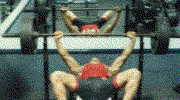 The
flat
bench press is without a doubt the most basic and effective means to build the
chest. The bench press should be the primary exercise for any chest routine, all
other exercises should be subordinate. You should provide you chest with a good
warmup cycle. For most people the basic 135 pounds is sufficient. If you cannot
use 135 as a warmup, try a lesser weight in which you can rep out at least 15
reps without any muscle strain. After a good warmup comes the real deal. Many
people do their routines different. For example, some people pyramid up then
back down, And some go right to the heavy weights then pyramid down. I prefer
the latter. After my warmup, I go to a weight of about 75% of my max
which is 375. So I work out with a weight of at least 280. The reason I
do this is because Im the strongest at the beginning of the routine, so I go
right to the heavy weights so I dont burn myself out on the lighter weight
leading up to the heavier weights. After I do a good amount of sets (between the
280-350 lb range), usually about 6 sets, I start to burn out. So, when it is
time to pyramid down in weight, I can do so without feeling I havent reached my
potential for the routine. I would much rather burn out on the sets coming down
than going up. I usually do an enormous amount of benchpress sets during my
chest work out (usually around the neighborhood of 10 sets. with the first 6
being with the heavier weights and the last four being pyramided down until I
finally reach the warmup poundage of 135). When I reach the warmup weight, I rep
out as many as I can until I cannot possibly do another. This gives me an awsome final pump for the bench
press. You can adjust your poundage
accordingly to match the routine described. For example, if your max is 275,
then try jumping straight to 225 after your warmup, then work your way back
down. The
flat
bench press is without a doubt the most basic and effective means to build the
chest. The bench press should be the primary exercise for any chest routine, all
other exercises should be subordinate. You should provide you chest with a good
warmup cycle. For most people the basic 135 pounds is sufficient. If you cannot
use 135 as a warmup, try a lesser weight in which you can rep out at least 15
reps without any muscle strain. After a good warmup comes the real deal. Many
people do their routines different. For example, some people pyramid up then
back down, And some go right to the heavy weights then pyramid down. I prefer
the latter. After my warmup, I go to a weight of about 75% of my max
which is 375. So I work out with a weight of at least 280. The reason I
do this is because Im the strongest at the beginning of the routine, so I go
right to the heavy weights so I dont burn myself out on the lighter weight
leading up to the heavier weights. After I do a good amount of sets (between the
280-350 lb range), usually about 6 sets, I start to burn out. So, when it is
time to pyramid down in weight, I can do so without feeling I havent reached my
potential for the routine. I would much rather burn out on the sets coming down
than going up. I usually do an enormous amount of benchpress sets during my
chest work out (usually around the neighborhood of 10 sets. with the first 6
being with the heavier weights and the last four being pyramided down until I
finally reach the warmup poundage of 135). When I reach the warmup weight, I rep
out as many as I can until I cannot possibly do another. This gives me an awsome final pump for the bench
press. You can adjust your poundage
accordingly to match the routine described. For example, if your max is 275,
then try jumping straight to 225 after your warmup, then work your way back
down.
|
 The
flatbench dumbell press is the only exercise that can even come close to the
bench press for building mass on the chest. The advantage that this has over the
benchpress is the range of motion. The bench press limits you in range because
the bar can only go as far as touching the chest. The dumbell press allows you
to go beyond that point. With the dumbells, you can get more of a
stretch. This exercise is done while lying on you back on a bench. I prefer
putting my feet on the end of the bench so I dont arch my back. This isolates
the chest more. Bring the dumbells down slowly and evenly and ensure the palms
are facing up and outward. When bringing the weights up, twist the wrists inward
so the palms are facing each other and pause for a second to squeeze the chest
muscles together. You want to do this for every rep. Do at least 4 sets with 8
to 10 reps per set. Adjust the weight accordingly if you cant achieve this. One
way to enhance this exercise is to to a very light weight of benchpress after
each set of dumbell presses. For example, after you do 10 reps of dumbell
presses. Jump right on the bench press (with a weight of only about 75 pounds on
the bar). You may be laughing at this light weight, but I guarantee after you do
it you wont be. Kick out as many reps as you can (Im sure it wont be many).
Repeat this for every set. The main thing to consider on this exercise is FORM. You want each rep to be
smooth and controlled. The
flatbench dumbell press is the only exercise that can even come close to the
bench press for building mass on the chest. The advantage that this has over the
benchpress is the range of motion. The bench press limits you in range because
the bar can only go as far as touching the chest. The dumbell press allows you
to go beyond that point. With the dumbells, you can get more of a
stretch. This exercise is done while lying on you back on a bench. I prefer
putting my feet on the end of the bench so I dont arch my back. This isolates
the chest more. Bring the dumbells down slowly and evenly and ensure the palms
are facing up and outward. When bringing the weights up, twist the wrists inward
so the palms are facing each other and pause for a second to squeeze the chest
muscles together. You want to do this for every rep. Do at least 4 sets with 8
to 10 reps per set. Adjust the weight accordingly if you cant achieve this. One
way to enhance this exercise is to to a very light weight of benchpress after
each set of dumbell presses. For example, after you do 10 reps of dumbell
presses. Jump right on the bench press (with a weight of only about 75 pounds on
the bar). You may be laughing at this light weight, but I guarantee after you do
it you wont be. Kick out as many reps as you can (Im sure it wont be many).
Repeat this for every set. The main thing to consider on this exercise is FORM. You want each rep to be
smooth and controlled. |
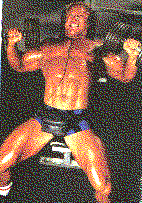 The
incline press, whether it be with dumbells or a straight bar, is an excellent means for
building the upper chest. The only precaution is to ensure you dont go to heavy
and damage or overwork the shoulders. The exercise is performed the same as with
the flatbench dumbell presses. You want to bring the weights down slowly and
controlled with wrists up and outward, and push up on the weights turning the
wrists inward to squeeze the chest at the end of the rep. With the straight bar,
bring the weights down to the top of the chest and slowly press upward. If your
shoulders permit, do 3 to 4 sets of these with 8 to 10 reps per set. The
principles for the decline exercise is exactly the same, the only difference
between the two is the angle of the bench. The decline press works the bottom of
the pecs which is a problem area for a lot of bodybuilders. You may find that
you can go a lot heavier on the decline than on the incline, take advantage of
this and really pump out the poundage. These exercises should be done toward the
end of the chest routine because of the strain that is put on the shoulders and
because these are primarily chest enhancement exercises for the chest and should
supplement the benchpress and flatbench dumbell press. The
incline press, whether it be with dumbells or a straight bar, is an excellent means for
building the upper chest. The only precaution is to ensure you dont go to heavy
and damage or overwork the shoulders. The exercise is performed the same as with
the flatbench dumbell presses. You want to bring the weights down slowly and
controlled with wrists up and outward, and push up on the weights turning the
wrists inward to squeeze the chest at the end of the rep. With the straight bar,
bring the weights down to the top of the chest and slowly press upward. If your
shoulders permit, do 3 to 4 sets of these with 8 to 10 reps per set. The
principles for the decline exercise is exactly the same, the only difference
between the two is the angle of the bench. The decline press works the bottom of
the pecs which is a problem area for a lot of bodybuilders. You may find that
you can go a lot heavier on the decline than on the incline, take advantage of
this and really pump out the poundage. These exercises should be done toward the
end of the chest routine because of the strain that is put on the shoulders and
because these are primarily chest enhancement exercises for the chest and should
supplement the benchpress and flatbench dumbell press.
|
 There is a
big misconception about the cable-cross
exercise. You must remember that this
exersise is NOT a mass builder but it is strictly a definer. This
exercise should not be used by beginners who still does not have a basic
foundation built. This exercise is mainly for builders with a chest foundation
already built and want to perfect it. I see it all the time in the gym where
newcomers perform many sets of cable crosses and all for nothing. The crosses
are what give the pecs shape and definition. (striations in the center of the
chest). It really isnt necessary to do extremely heavy weights with this machine
because like I said before, it is used to perfect what you already have.
Therefore what is important is the form and the number of reps. You want to go
with a weight in which you can perform up to 15 reps with. Start with the arms
straight out as the pictures shows and bring your hands together while keeping
the arms straight. Try to avoid bending the arms as much as possible. Hold the
arms in this position for a second and squeeze the pec muscles together. Repeat
this for every rep. There is a
big misconception about the cable-cross
exercise. You must remember that this
exersise is NOT a mass builder but it is strictly a definer. This
exercise should not be used by beginners who still does not have a basic
foundation built. This exercise is mainly for builders with a chest foundation
already built and want to perfect it. I see it all the time in the gym where
newcomers perform many sets of cable crosses and all for nothing. The crosses
are what give the pecs shape and definition. (striations in the center of the
chest). It really isnt necessary to do extremely heavy weights with this machine
because like I said before, it is used to perfect what you already have.
Therefore what is important is the form and the number of reps. You want to go
with a weight in which you can perform up to 15 reps with. Start with the arms
straight out as the pictures shows and bring your hands together while keeping
the arms straight. Try to avoid bending the arms as much as possible. Hold the
arms in this position for a second and squeeze the pec muscles together. Repeat
this for every rep.
The exercises described above have made a world of difference in my chest
development. I hope they will work for you as well. Along with your dedication
and a will to try new things, they will. Always remember that the only thing
that you will get out of this game is what you put into it.
|
|
  
Kris now moves
to incline dumbbell presses. Kris maintains the standard 45 degrees angle on the
bench. Sometimes Kris will lower the angle just to keep the muscles
confused. He
cautions not to raise the angle above 45 degrees or you will fatigue your
shoulders. Notice how Kris will touch the dumbbell at the top of the movement to
force the muscle to really contract. "By touching the dumbbells and squeezing
the pecs together, you will begin to develop those deep striations that separate
your left and right pecs."
|
|
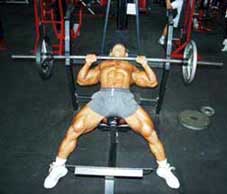

Unlike most
training routines that start with flat bench presses. Kris likes to throw it
right into the middle of his routine. His grip is slightly wider than his
shoulders, and he lowers the bar to the peak of chest. Once again Kris'
movements are controlled and powerful as he performs each rep. Kris likes to do
his flat benches in the middle of the workout because he says it makes his whole
chest burn like crazy!
|
|
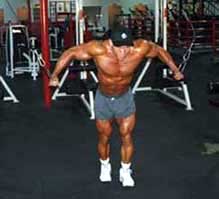

Now for the
finishing touches. "I love to finish with cross cables. I really bomb my chest
on this one. I make sure that every fiber of muscle in my chest is screaming for
me to stop". Kris starts from an upright position with his arms as wide as
possible. As the cables come together he allows them overlap a couple of inches.
Now comes the super squeeze: Kris forces his chest to contract almost to the
point of cramping. This brings out every vein and striation and is a must for
developing an awesome most "muscular pose."
The results
are nothing short of awesome, as Kris shows how impressive a massive chest can
be. Kris is now ready to go lie by the pool and suck up a MaxPro shake. I wonder
if he'll take his shirt off at the pool? Wouldn't we all if we had a chest like
Kris. |
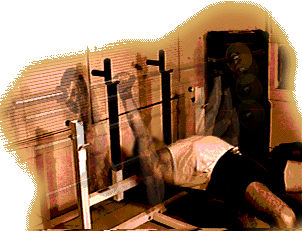 |
Sweat That Chest!
Each set consists of eight repetitions. To
warm up: Do a set at fifty percent of your maximum effort. Begin with
three sets of eight. When you can't break a sweat with that, add five more
reps to each set.
Bench press.
Lying on an exercise bench, grasp a barbell with your hands slightly more
than shoulder-width apart. Lower the bar slowly until it touches your
chest. |
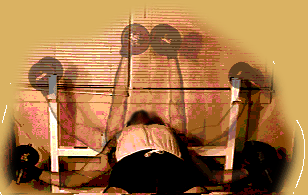 |
Dumbbell
fly. Holding two dumbbells, lie on an exercise bench. Extend
your arms straight up above your shoulders, palms facing each other. Bend
your elbows slightly, and lower the dumbbells out to your sides. Be sure
to keep your palms facing each other at all times. |
 |
Incline
press. Sitting at an incline bench press, grasp a barbell with
your hands so they're slightly more than shoulder-width apart. Lower the
bar until it touches the top of your chest. Raise the bar until your arms
are extended.
The Pec-Deck. Sit in the Pec-Deck machine.
Grasp the bars so your forearms are perpendicular to the floor. Slowly
squeeze your forearms together. Ease the bars back to your sides as far as
you can, then do it again.
The one to do if you're doing only one? The
bench press. |
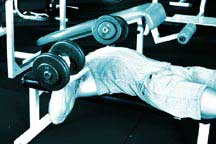
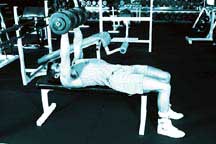
|
Flat Dumbell Press or Bench Press
From
a lying position with the dumbbells resting on your outer chest, press the
weight upward and inward. The inner portion of the dumbbells should touch
as you approach the top of the movement. If you are performing a bench
press with a barbell, start with a grip 4-6 inches wider than your
shoulders, lower the bar towards the peak of your chest or slightly above
it. Press upward until your elbows lock out. As you approach the top of
either movement squeeze the chest muscles inward to intensify the muscle
contraction.
* Muscle Confusion Tips:
Alternate workouts doing Dumbbell Pressev one week and bench presses the
next. Widen the path of the dumbbells as you lower the weight very slowly.
Grip the barbell wider (6-10 inches) and lower the barbell to the upper
portion of ,our chest, be sure to uve a lighter weight. |


|
Incline Bench Press or Dumbell
Press
Grip
the bar 6-8 inches wider than shoulders. Lower the bar to the upper
portion of your chest. Press upward until your elbows lock out. As you
approach the top of either movement squeeze the chest muscles inward to
intensify the muscle contraction. This movement can also be done with
dumbbells as described above, using an incline bench.
* Muscle Confusion Tip:
Change the angle of the bench, don't go above 45 degrees or you will begin
use too much shoulders. You can elevate a flat bench as little as 3 or 4
inches and this considered an incline movement. Your gym may have incline
pressing machines, try them all to keep your muscles confused. |


|
Maching Flys
Start with your arms spread out as shown in
the first photo. Be sure to keep your elbows slightly bent throughout the
entire movement. The pictures best describe how to perform this exercise.
Notice the incredible stretch and range of motion that this movement
demands. Try using different machines at your gym, there is usually more
than one machine for this exercise.
* Muscle Confusion Tips:
Use dumbbells with a flat or slight incline angle bench while doing a wide
fly motion as shown in the photos. You can also do this movement with low
pulley cables while laying on a flat bench. |
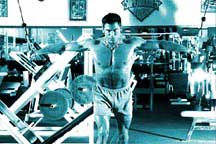
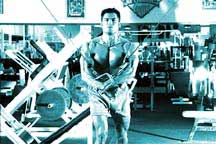
|
Cable
Crossovers
The
movement of this exercise is very similar to that of the machine fly as
described above. Notice how this movement forces the chest muscle to
contract and striate as you crossover at the end of the movement. Pause
slightly after you crossover and feel the bum within the muscles as the
contraction intensifies. Concentrate on feeling the stretch at the top of
the movement. This movement is awesome to finish with because it really
burns you out.
* Muscle Confusion Tips:
The reps and weight on this movement are the best way to incorporate
muscle confusion. Try doing as many as 25 reps with a lighter weight to
really finish your chest workout. |
Definitely
one of the most popular bodyparts to train, possibly only second to biceps. The
pec's actually consist of 2 main muscles (per side), pec minor and pec major.
Pec major is the one you see, pec minor is underneath it, but shouldn't be
neglected.
The old stand by is the bench press, and for good reason. It
is a great way to build some mass, you can use a lot of weight safely, and don't
have to focus so much on form as you do with dumbbells. But the extra balancing
required with dumbbells is exactly what makes dumbell presses a great exercise
for blasting through training plateaus. It brings into play muscles all over the
place, and if you switch to dumbell presses as opposed to barbell presses for
say 3 workouts, I guarantee you'll go back to you bench press stronger.
|
| |
Barbell Bench PressNot too much to say
here, I'm sure most everyone has done them! Here's some common mistakes I still
see in the gym (and can't believe I do see some of them), and some tips:
- Don't bounce the weight off your chest!
I can't fathom what people
are thinking when they do this, it just blows my mind! You risk some major
injury, and aren't even putting your muscles under continuous stress. Sure you
could maybe 'lift' more, though I hardly call it lifting.
- Your elbows should, at the bottom of the motion, be at a 45 degree angle
to your body to take some stress off your shoulders.
- Use a wider grip to avoid involving the triceps. At the bottom of the
motion your elbows should be at a 90 degree angle.
- Don't arch your back, or lift your ass off the
bench.
- Lower the bar to near the bottom of your chest. The easiest way to
accomplish this is to concentrate on your forearms always pointing straight up.
- Don't lockout your elbows at the top of the
movement.
Muscle Media
has a nice article on improving your bench press, so check it out!
|
| |
Dumbell Bench PressAs I said earlier,
this exercise is excellent for pushing through a sticking point. The last time I
tried it, I increase my barbell bench by about 20 pounds after 2 weeks. This
exercise involves so many surrounding/supportive muscles that don't get
activated too much by a barbell bench, but when you go back to the barbell
bench, those muscle are there to help you push even harder! I would recommend
switching this exercise off with a barbell bench every couple of weeks, or when
you feel like you need it.
- Sit on the end of a bench with the dumbbells resting on your knees. You
may need someone to help you lift the weight to here.
- Lie down, bring the weight with you, so that you are lying flat on the
bench, the dumbbells next to your waist.
- The first rep is the hardest (well, actually the last rep should be the
hardest!), so get a spotter to help you lift the weight the first time. This
is only if you are using really heavy weights. If you don't have a spotter,
you could always use less weight and slow down your reps!
- Another benefit of this exercise is that it lets you lower the weight
further, and get a fuller contraction at the top of the movement. If you can't
seem to get sore, or just want a really good stretch, squeeze you shoulder
blades together at the bottom of the rep. I've heard people say you shouldn't
let your arms go below parallel with the floor, though I can't imagine why!
Maybe as a partial rep.
- Try to keep your forearms pointing straight up.
- Don't lockout your elbows at the top of the movement, as this causes a big
loss in stability.
|
|

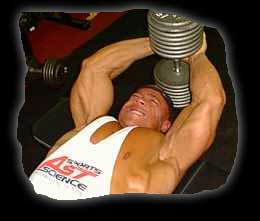
|
Pullovers
This exercise directly targets the pec minor. You lie
on a bench with only your shoulder blades/traps resting on the bench ( so
you and the bench make a T ). Your feet should be flat on the floor, knees
bent, butt hanging low. Now grab a (light) weight, raise it above your
head, and lower it behind your head, keeping your arms straight, but
elbows not locked. Lower it as far as possible to get a good stretch, and
raise only to a point where the resistance begins to drop off.
When I see people doing this exercise,
I almost always see them lift the weight until it is straight above their heads
so you can really squeeze your pecs. That's all nice and good, but this exercise
isn't for your pec major anyway, and doing this motion doesn't keep the pec
minor under constant tension.
- Lie on a bench, perpendicular to it, with only your upper back on the
bench, feet flat on the floor, knees bent, ass hanging low.
- Lift a weight and lower it as far as you can behind your head, keeping
your arms straight, but not locked.
- Lift the weight only about 30 degrees or until the tension is taken off
the pec minor.
This exercise give a great stretch, and works an
otherwise unused muscle, adding yet more size to your chest than pressing
movements alone could bring.
|
Variations of BenchVariations
include:
- Decline bench: head is lower than body, isolates chest more, not involving
shoulders as much, also really good for close-grip to target the triceps.
- Incline bench: Uses shoulders a lot more, and can really develop your pecs
closer to your collarbone. This should almost be a part of most every chest
workout for even development.
- Various grips can also be used to target different muscle fibers. A
narrower grip involves more triceps whereas a wider grip isolates the chest.
Sample routines for the Chest
- 3-4 consecutive warm up sets on bench press, increasing weight, reps of
8,6,4,2, followed by 3 minute rest
- 2-3 working sets of flat bench (barbell or dumbell), reps of ~6(heavy) or
~10(light), rest of 2(light)-4(heavy) minutes.
- 2-3 working sets of incline bench, (barbell or dumbell) same rep and time
range as flat bench.
- 2-3 sets of pullover, lighter weight, 8-10 reps
- 1-2 sets of fly's for a good stretch. Use less weight, but let the weight
nearly touch the floor.
|
|
[ Tips for beginners ] [ guns ] [ tri ] [ chest ] [ back ] [ delts shoulders ] [ abs ] [ quads hams ] [ tips ] [ tips - next ] [ composition des aliments ]
| |
|